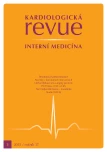Pharmacological and non-pharmacological treatment of atrial fibrillation – a current view
Authors:
J. Petrů
Authors‘ workplace:
Kardiocentrum, Nemocnice Na Homolce, Praha
Published in:
Kardiol Rev Int Med 2015, 17(3): 221-224
Category:
Cardiology Review
Overview
Atrial fibrillation (AF) is the most common cardiac arrhythmia in developed countries. The presence of AF increases the risk of stroke, heart failure, dementia and death. Although antiarrhythmic drugs have an important role in the treatment of AF, catheter ablation in most aspects provides better treatment results and in some cases may lead to a cure. This article summarises the current view on the treatment of AF, with special emphasis on catheter ablation.
Keywords:
atrial fibrillation – catheter ablativ – antiarrhythmic therapy
Sources
1. Wolf PA, Benjamin EJ, Belanger AJ et al. Secular trends in the prevalence of atrial fibrillation: The Framingham Study. Am Heart J 1996; 131 : 790 – 795.
2. Ott A, Breteler MM, de Bruyne MC et al. Atrial fibrillation and dementia in a population‑based study. The Rotterdam Study. Stroke 1997; 28 : 316 – 321.
3. Lin HJ, Wolf PA, Kelly ‑ Hayes M et al. Stroke severity in atrial fibrillation. The Framingham Study. Stroke 1996; 27 : 1760 – 1764.
4. January CT, Wann LS, Alpert JS et al. 2014 AHA/ ACC/ HRS guideline for the management of patients with atrial fibrillation: a report of the American College of Cardiology/ American Heart Association Task Force on practice guidelines and the Heart Rhythm Society. Circulation 2014; 130. doi: 10.1161/ CIR.0000000000000041.
5. Le Heuzey JY, De Ferrari GM, Radzik D et al. A short‑term, randomized, double‑blind, parallel ‑ group study to evaluate the efficacy and safety of dronedarone versus amiodarone in patients with persistent atrial fibrillation: the DIONYSOS study. J Cardiovasc Electrophysiol 2010; 21 : 597 – 605. doi: 10.1111/ j.1540 – 8167.2010.01764.x.
6. Freemantle N, Lafuente ‑ Lafuente C, Mitchell S et al. Mixed treatment comparison of dronedarone, amiodarone, sotalol, flecainide, and propafenone, for the management of atrial fibrillation. Europace 2011; 13 : 329 – 345. doi: 10.1093/ europace/ euq450.
7. Singh BN, Singh SN, Reda DJ et al. Amiodarone versus sotalol for atrial fibrillation. N Engl J Med 2005; 352 : 1861 – 1872.
8. Vaidya K, Arnott C, Russell A et al. Pulmonary vein isolation compared to rate control in patiens with atrial fibrillation: a systematic review and meta‑analysis. Heart Lung Circ 2015; 24 : 744 – 752. doi: 10.1016/ j.hlc.2015.02.025.
9. Haissaguerre M, Marcus FI, Fischer B et al. Radiofrequency catheter ablation in unusual mechanisms of atrial fibrillation: report of three cases. J Cardiovasc Electrophysiol 1994; 5 : 743 – 751.
10. Pappone C, Augello G, Sala S et al. A randomized trial of circumferential pulmonary vein ablation versus antiarrhythmic drug therapy in paroxysmal atrial fibrillation: the APAF Study. J Am Coll Cardiol 2006; 48 : 2340 – 2347.
11. Stabile G, Bertaglia E, Senatore G et al. Catheter ablation treatment in patiens with drug‑refractory atrial fibrillation: a prospective, multi‑centre, randomized, controlled study. Eur Heart J 2006; 27 : 216 – 221.
12. Wilber DJ, Pappone C, Neuzil P et al. Comparison of antiarrhythmic drug therapy and radiofrequency catheter ablation in patiens with paroxysmal atrial fibrillation: a randomized controlled trial. JAMA 2010; 303 : 333 – 340. doi: 10.1001/ jama.2009.2029.
13. Tung R, Buch E, Shivkumar K et al. Catheter Ablation of Atrial Fibrillation. Circulation 2012; 126 : 223 – 229. doi: 10.1161/ CIRCULATIONAHA.111.048421.
14. Hsu LF, Hais P, Sanders P et al. Catheter ablation for atrial fibrillation in congestive heart failure. N Engl J Med 2004; 351 : 2373 – 2383.
15. Bertaglia E, Tondo C, De Simone A et al. Does catheter ablation cure atrial fibrillation? Single‑procedure outcome of drug‑refractory atrial fibrillation ablation: a 6‑year multicentre experience. Europace 2010; 12 : 181 – 187. doi: 10.1093/ europace/ eup349.
16. Weerasooriya R, Khairy P, Litalien J et al. Catheter ablation for atrial fibrillation, are results maintained at 5 years of follow‑up? J Am Coll Cardiol 2011; 57 : 160 – 166. doi: 10.1016/ j.jacc.2010.05.061.
17. Abed HS, Witter GA, Leong DP et al. Effect of weight reduction and cardiometabolic risk factor management on symptom burden and severity in patiens with atrial fibrillation. JAMA 2013; 310 : 2050 – 2060. doi: 10.1001/ jama.2013.280521.
18. Gami AS, Somers VK. Implications of obstructive sleep apnea for atrial fibrillation and sudden cardiac death. J Cardiovasc Electrophysiol 2008; 19 : 997 – 1003. doi: 10.1111/ j.1540 – 8167.2008.01136.x.
19. Holmquist F, Guan N, Zhu Z et al. Impact of obstructive sleep apnea and continuous positive airway pressure therapy on outcomes in patiens with atrial fibrillation – Results from the Outcomes Registry for Better Informed Treatment of Atrial Fibrillation (ORBIT ‑ AF). Am Heart J 2015; 169 : 647 – 654. doi: 10.1016/ j.ahj.2014.12.024.
20. Anselmino M, Matta M, D’Ascenzo F et al. Catheter ablation of atrial fibrillation in patients with left ventricular systolic dysfunction: a systematic review and meta‑analysis. Circ Arrhythm Electrophysiol 2014; 7 : 1011 – 1018. doi: 10.1161/ CIRCEP.114.001938.
21. Santangeli P, Di Biase L, Horton R et al. Ablation of atrial fibrillation under therapeutic warfarin reduces periprocedural complications: evidence from a meta‑analysis. Circ Arrhythm Electrophysiol 2012; 5 : 302 – 311. doi: 10.1161/ CIRCEP.111.964916.
22. Nairooz R, Sardar P, Payne J et al. Meta‑analysis of major bleeding with uninterrupted warfarin compared to interrupted warfarin and heparin bridging in ablation of atrial fibrillation. Int J Cardiol 2015; 187 : 426 – 429. doi: 10.1016/ j.ijcard.2015.03.376.
Labels
Paediatric cardiology Internal medicine Cardiac surgery CardiologyArticle was published in
Cardiology Review

2015 Issue 3
Most read in this issue
- Cardiac arrest and post‑cardiac arrest care
- Therapeutic approaches in exertional angina pectoris
- Leadless cardiac stimulation – future or fiction?
- A new device in intervention therapy of heart failure with preserved ejection fraction of left ventricle
